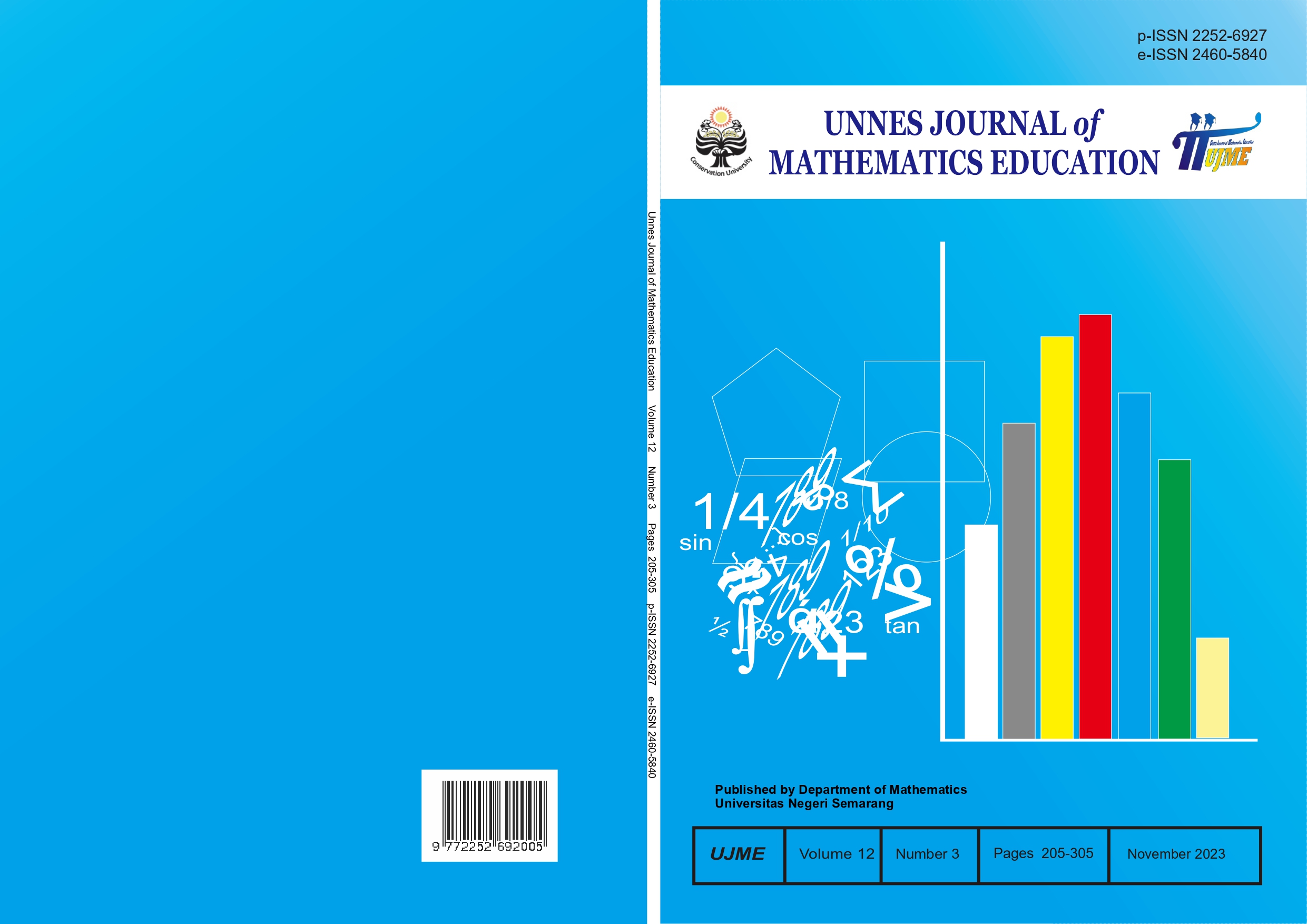Mathematical Connection Ability Viewed from Self Efficacy in CONINCON Learning Model with Ethnomathematics Nuances
##plugins.themes.academic_pro.article.main##
Abstract
This study aims to (1) find out whether the proportion of students with mathematical connection abilities ≥ minimum criteria of mastery learning in CONINCON learning model with ethnomathematics nuances was more than the learning completeness limit, namely 75%; (2) find out whether students' mathematical connection abilities through CONINCON learning model with ethnomathematics nuances were better than students' connection abilities with Problem Based Learning model; (3) find out whether students' self efficacy influences mathematical connection abilities; (4) describe mathematical connection abilities through CONINCON learning model with ethnomathematics nuances viewed from students' self efficacy. The method used was a mixed method with a sequential explanatory design. In this research, 6 research subjects were taken based on the category of self efficacy in experimental group. Research results show that (1) proportion of students with mathematical connection abilities ≥ minimum criteria of mastery learning in CONINCON learning model with ethnomathematics nuances was more than the learning completeness limit, namely 75%; (2) students' mathematical connection abilities in CONINCON learning model with ethnomathematics nuances were better than students' connection abilities in Problem Based Learning model; (3) students' self efficacy has a significant influence on mathematical connection abilities of 68.7%; (4) description of students' mathematical connection abilities with categories : (a) high category of self efficacy are able to fullfill all indicators of mathematical connection abilities; (b) medium category of self efficacy can fulfill two indicators and less able to fullfill two indicators; (c) low category of self efficacy only fulfill an indicator.
##plugins.themes.academic_pro.article.details##
References
Fadilah, R. R., Adiastuty, N., & Sumarni, S. (2021). ANALISIS KEMAMPUAN KONEKSI MATEMATIS SISWA PADA MATERI SEGIEMPAT DITINJAU DARI SELF-REGULATED LEARNING. Jurnal Edukasi Dan Sains Matematika (JES-MAT), 7(1), 17–30. https://doi.org/10.25134/jes-mat.v7i1.3699
Fitasari, N. P. D., Suniasih, N. W., & Agustika, G. N. S. (2019). Pengaruh Pola Asuh Orang Tua Terhdap Hasil Belajar Matematika dengan Efikasi Diri Sebagai Intervening. International Journal of Elementary Education, 3(4), 404–412. https://doi.org/10.23887/ijee.v3i4.21313
Hasbi, M., Lukito, A., Sulaiman, R., & Muzaini, M. (2019). Improving the Mathematical Connection Ability of Middle-School Students through Realistic Mathematics Approach. Journal of Mathematical Pedagogy (JoMP), 1(1), 37–46. https://doi.org/10.26740/jomp.v1n1.p37-46
Isfayani, E., Johar, R., & Munzir, S. (2018). Peningkatan Kemampuan Koneksi Matematis dan Self- Efficacy Siswa melalui Model Pembelajaran Kooperatif Tipe Rotating Trio Exchange (RTE). Jurnal Elemen, 4(1), 80–92. https://doi.org/10.29408/jel.v4i1.473
Iswara, R., Dewi, N. R., & Cahyono, A. N. (2021). Student Mathematic Connection Ability Through Ict Assisted Preprospec Learning Model. Unnes Journal of Mathematics Education Research, 10(2), 122–128.
Kartika, Y. K., Pujiastuti, E., & Soedjoko, E. (2019). The Effectiveness of Project Based Learning with Creative Mind-Map Tasks for Improving Mathematical Connection Ability and Student Curiosity. Unnes Journal of Mathematics Education, 8(2), 145–151. https://doi.org/10.15294/ujme.v8i2.31937
Kemendikbud. (2016a). Permendikbud Nomor 21 Tahun 2016 Tentang Standar Isi Pendidikan Dasar dan Menengah. Kemendikbud.
Kemendikbud. (2016b). Permendikbud Nomor 22 Tahun 2016 Tentang Standar Proses Pendidikan Dasar dan Menengah. Kemendikbud.
Kenedi, A. K., Helsa, Y., Ariani, Y., Zainil, M., & Hendri, S. (2019). MATHEMATICAL CONNECTION OF ELEMENTARY SCHOOL STUDENTS TO SOLVE MATHEMATICAL PROBLEMS. Journal on Mathematics Education, 10(1), 69–80. https://doi.org/10.22342/jme.10.1.5416.69-80
Maulida, A. R., Suyitno, H., & Asih, T. S. N. (2019). Kemampuan Koneksi Matematis pada Pembelajaran CONINCON (Constructivism, Integratif and Contextual) untuk Mengatasi Kecemasan Siswa. PRISMA, Prosiding Seminar Nasional Matematika, 2, 724–731.
Maulida, A. R., Suyitno, H., & Asih, T. S. N. (2022). Mathematical Connection Ability viewed from Cognitive Style and Gender in the CONINCON Learning (Constructivism, Integrative & Contextual). Unnes Journal of Mathematics Education Research, 11(2), 127–134.
Mukhtari, Z., Yuliani, A., & Hendriana, H. (2019). ANALISIS PENGARUH SELF EFFICACY TERHADAP KEMAMPUAN KONEKSI MATEMATIK SISWA SMP PADA MATERI BANGUN RUANG SISI DATAR. Jurnal Pembelajaran Matematika Inovatif, 2(5), 337–346.
Nugraha, A. A. (2018). Analisis Koneksi Matematis Siswa pada Materi SPLDV. Suska Journal of Mathematics Education, 4(1), 59–64. https://doi.org/10.24014/sjme.v4i1.4579
Nugraheni, M. D., & Junaedi, I. (2019). The Mathematics Connection Ability of 8th Grade Students In Terms of Cultural Capital in Brain-Based Learning. Unnes Journal of Mathematics Education, 8(2), 128–134. https://doi.org/10.15294/ujme.v8i2.32480
Nurafni, A., & Pujiastuti, H. (2019). Analisis Kemampuan Koneksi Matematis ditinjau dari Self Confidence Siswa: Studi Kasus Di SMKN 4 Pandeglang. ANARGYA: Jurnal Ilmiah Pendidikan Matematika, 2(1), 27–33. https://doi.org/10.24176/anargya.v2i1.3013
OECD. (2022). Mathematics Performance (PISA) (Indicator).
PISA. (2018). Results Combined Executive Summaries.
Rahmi, Febriana, R., & Putri, G. E. (2020). Pengaruh Self efficacy terhadap Pemahaman Konsep Matematika dengan Menerapkan Model Discovery Learning pada Siswa Kelas XI MIA 1 SMA N 5 Solok Selatan. Edumatica: Jurnal Pendidikan Matematika, 10(1), 27–34.
Reksadini, M., Rochmad, R., & Junaedi, I. (2022). Mathematical Connection Ability Based on Self Confidence of Class XI Students in STEM-Based CONINCON Learning. Unnes Journal of Mathematics Education Research, 11(1), 88–96.
Simamora, R. E., Saragih, S., & Hasratuddin. (2018). Improving Students’ Mathematical Problem Solving Ability and Self efficacy through Guided Discovery Learning in Local Culture Context. International Electronic Journal of Mathematics Education, 14(1), 61–72. https://doi.org/10.12973/iejme/3966
